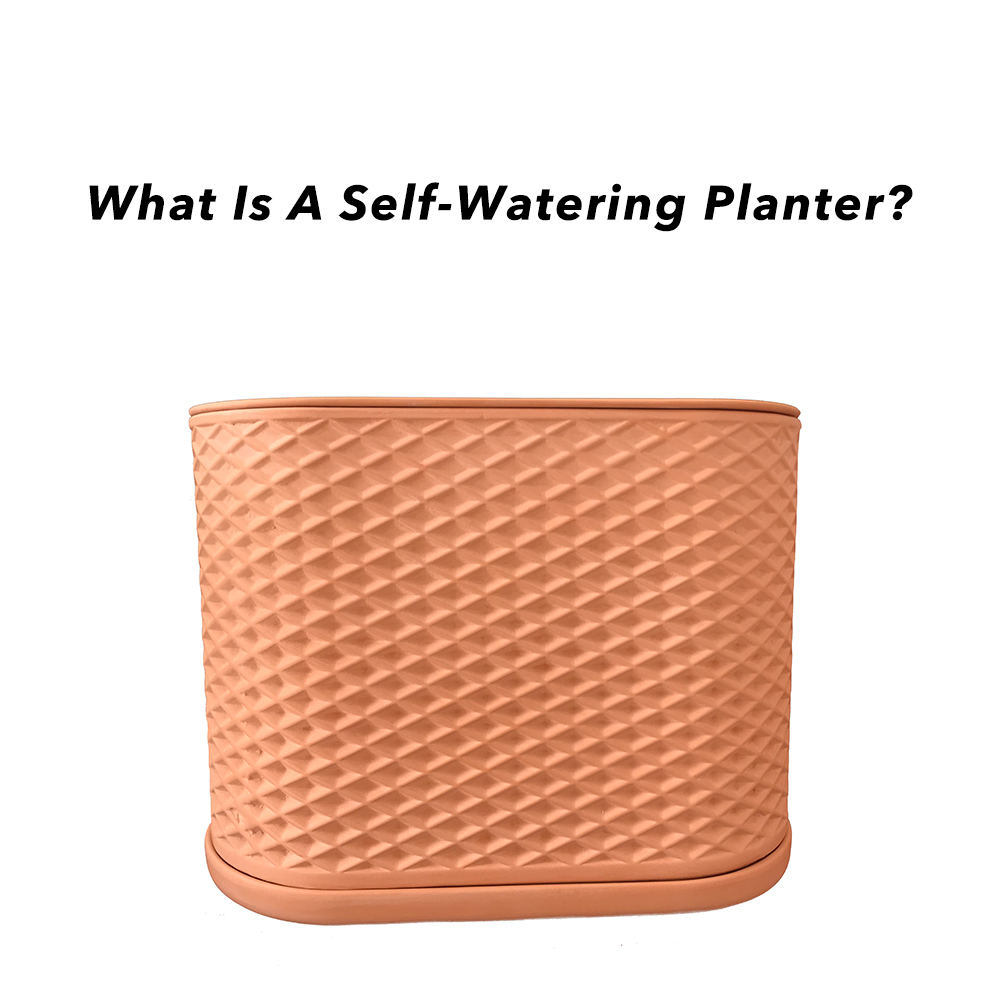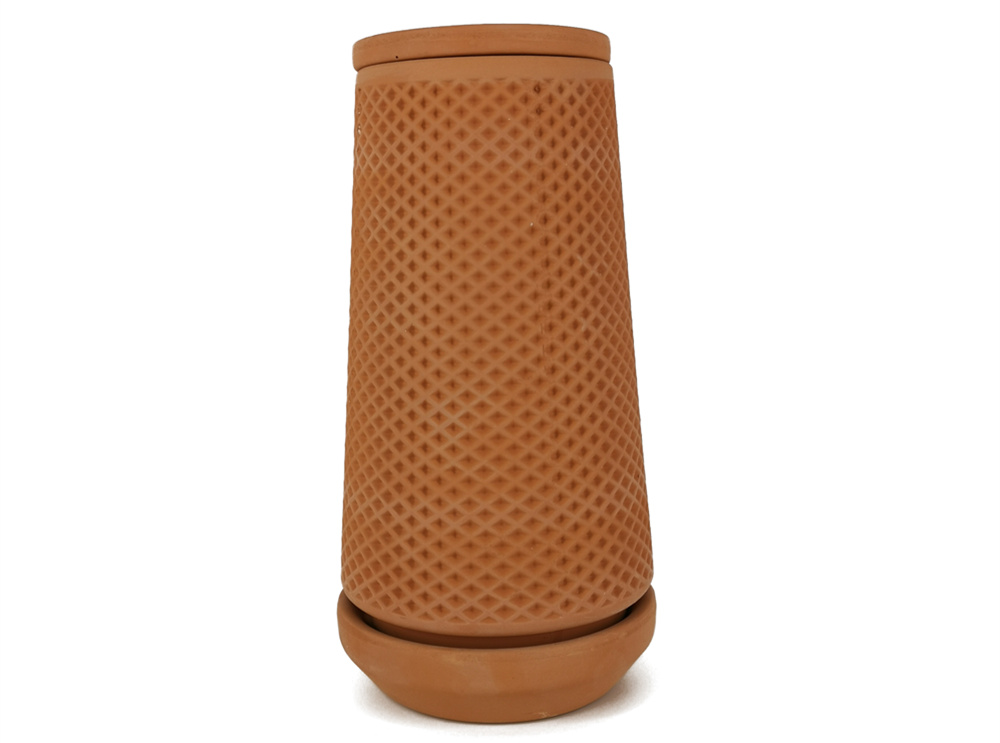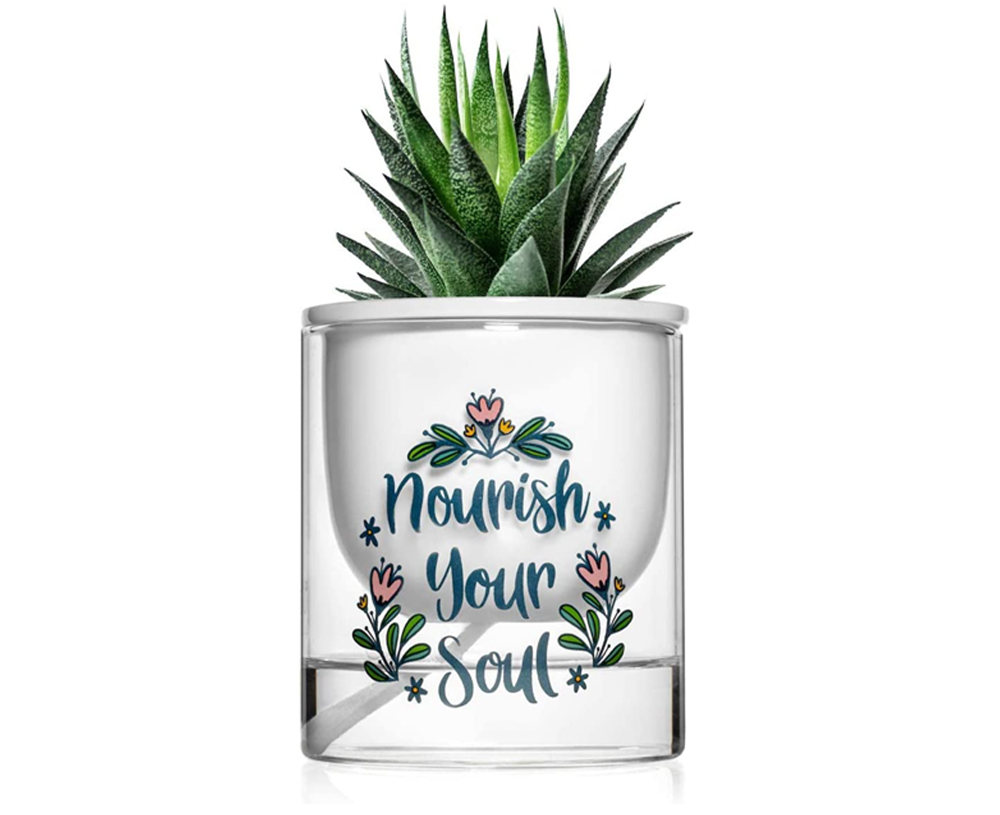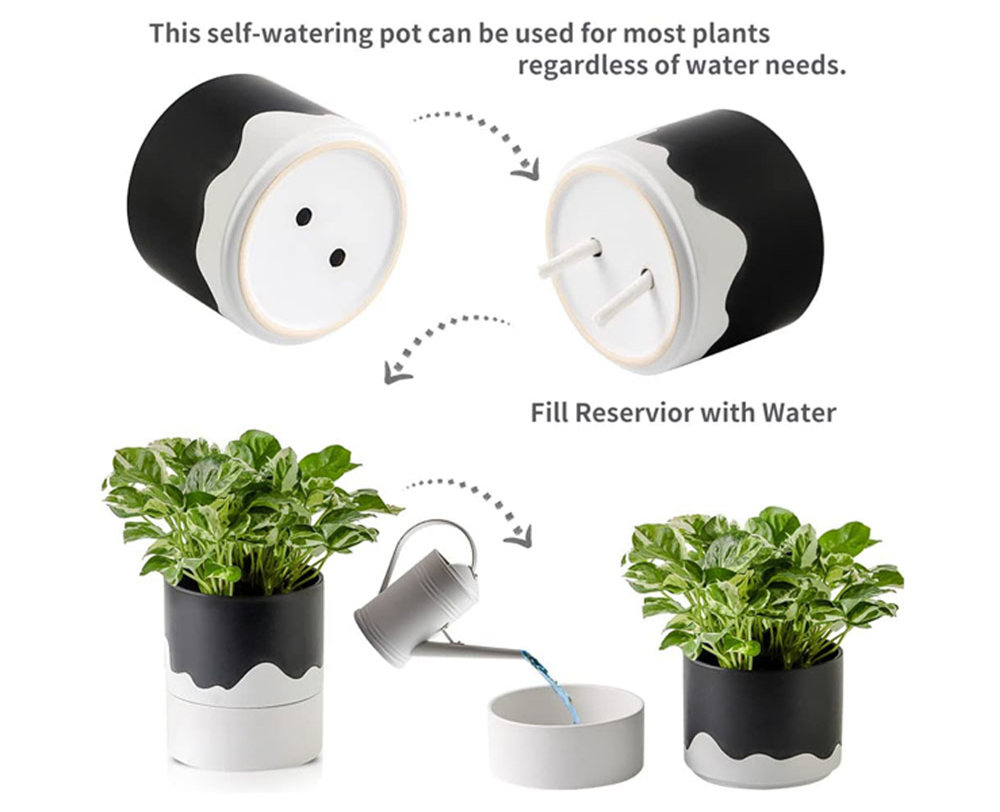What Is A Self Watering Planter Pot?
Time of issue: 2024-04-10 11:07:04
Introduction:
In the realm of plant care innovations, self-watering planters have emerged as a revolutionary solution for both novice and seasoned gardeners alike. These ingenious containers offer a hassle-free way to keep your plants hydrated and thriving, even in the midst of busy schedules or erratic watering habits. In this in-depth exploration, we unravel the concept of self-watering planters, shedding light on their mechanisms, benefits, and practical applications.
What is The Basic Elements of A Self-Watering Pot?
Self-watering pots have revolutionized the way we care for our plants, offering a convenient and efficient solution to watering challenges. These innovative containers are equipped with a clever system that delivers water directly to the plant's roots, ensuring optimal moisture levels without the need for frequent watering.
Reservoir:
At the core of a self-watering pot lies the reservoir, a dedicated compartment designed to hold water. This reservoir is typically located at the base of the pot and is separated from the soil chamber by a barrier, such as a perforated platform or insert. The size of the reservoir can vary depending on the pot's design and capacity, with larger pots often featuring larger reservoirs to accommodate more water.
Wicking Mechanism:
One of the key components of a self-watering pot is the wicking mechanism, which facilitates the transfer of water from the reservoir to the soil. This mechanism typically consists of a porous material, such as a wick or capillary mat, that extends from the reservoir into the soil chamber. Through capillary action, water is drawn upward from the reservoir and distributed evenly throughout the soil, ensuring that the plant's roots receive a steady supply of moisture.
Soil Chamber:
The soil chamber is where the plant is housed, along with its growing medium. This chamber is filled with soil or potting mix, which acts as a reservoir for water absorbed from the wicking mechanism. The soil chamber is essential for providing a supportive environment for the plant's roots, allowing them to access water and nutrients as needed for growth and development.
Overflow Drainage:
To prevent waterlogging and ensure proper aeration of the root zone, self-watering pots are equipped with overflow drainage mechanisms. These mechanisms allow excess water to escape from the soil chamber and drain away from the pot, preventing water from accumulating and causing root rot or other moisture-related issues. Overflow drainage may take the form of drainage holes at the base of the pot or a built-in overflow spout or tube.
What Kind Of Ceramic Self Watering Planter Pot?
Ceramic self-watering planter pots offer a harmonious marriage of aesthetics and practicality, appealing to both plant lovers and interior decorators. With their versatility and functionality, these pots come in various types, each serving a unique purpose and style.
Honeycomb Terracotta Self-Watering Flowerpot:

The honeycomb terracotta self-watering flowerpot blends the rustic allure of traditional terracotta with modern irrigation technology. These pots feature a captivating honeycomb pattern on their exteriors, adding texture and visual interest to any space. Internally, they house a self-watering system consisting of a built-in reservoir and a wicking mechanism. This design ensures efficient water delivery directly to the plant's roots, fostering healthy growth and preventing over or under-watering. With their earthy tones and tactile surface, honeycomb terracotta self-watering flowerpots bring a touch of warmth and authenticity to indoor and outdoor environments, making them a favored choice for plant enthusiasts seeking both style and functionality.
Double-Wall Self-watering Ceramic Planter Pot:

The double-wall ceramic planter pot epitomizes contemporary elegance and ingenuity in plant design. Characterized by its sleek silhouette and dual-layered construction, this pot features an outer shell that provides insulation and an inner reservoir for water storage. Through a self-watering mechanism, water is absorbed by the inner wall and distributed to the plant's roots via capillary action. The outer shell acts as a barrier, regulating temperature and moisture levels for optimal plant health. With its clean lines and modern aesthetic, the double-wall ceramic planter pot adds a sophisticated touch to any indoor or outdoor space, making it a preferred choice for urban dwellers and minimalist enthusiasts.
Double-Layer Self-watering Ceramic Plant Pot:

The double-layer ceramic plant pot offers a fusion of functionality and style, catering to the needs of both plant aficionados and interior decorators. These pots feature a dual-layered design, with an outer shell for aesthetic appeal and an inner reservoir for water storage. The self-watering mechanism operates by allowing water to seep through the inner layer and reach the plant's roots, ensuring consistent moisture levels and healthy growth. With their versatility and timeless charm, double-layer ceramic plant pots are suitable for a wide range of plant varieties and decor styles, from classic to contemporary.
What Advantage Of Self-Watering Planters?
Self-watering planters have gained immense popularity among gardening enthusiasts, revolutionizing the way we care for our beloved plants. These innovative containers offer numerous advantages that make them a preferred choice for both novice and experienced gardeners alike.
Consistent Moisture Levels:
One of the primary advantages of self-watering planters is their ability to maintain consistent moisture levels in the soil. Traditional watering methods often result in fluctuations in soil moisture, leading to periods of drought stress followed by overwatering. Self-watering planters, however, deliver water directly to the plant's roots as needed, ensuring a steady supply of moisture. This consistent hydration helps plants thrive, promoting lush foliage, vibrant blooms, and overall healthier growth.
Water Efficiency:
Self-watering planters are highly efficient when it comes to water usage. By delivering water directly to the root zone, these containers minimize water wastage and evaporation, conserving precious resources. The built-in reservoirs in self-watering planters also help reduce the frequency of watering, as plants can draw from the reservoir as needed. This water-saving feature not only benefits the environment but also saves time and effort for gardeners, making plant care more sustainable and convenient.
Reduced Maintenance:
Maintaining optimal soil moisture levels can be a time-consuming task for gardeners, especially in hot or dry climates. Self-watering planters alleviate much of this burden by automating the watering process. With self-watering systems in place, gardeners can enjoy extended periods between watering sessions, allowing them to focus on other aspects of plant care or leisure activities. Additionally, self-watering planters help prevent common watering mistakes such as overwatering or underwatering, reducing the risk of plant stress and disease.
Healthier Plants:
Consistent moisture levels provided by self-watering planters contribute to healthier plant growth. When plants receive the right amount of water at the right time, they can allocate more energy towards essential functions such as photosynthesis, root development, and flower production. Proper hydration also helps plants withstand environmental stressors such as heat waves or dry spells, resulting in stronger, more resilient specimens. With self-watering planters, gardeners can enjoy the satisfaction of nurturing thriving, vibrant plants with minimal effort.
What are FAQ of self-watering plant pot?
Self-watering plant pots have gained popularity for their convenience and efficiency in plant care. However, many gardeners have questions about how these innovative containers work and how to best utilize them.
How often do you put water in a self-watering planter?
The frequency of watering a self-watering planter depends on various factors, including the plant's water needs, environmental conditions, and the size of the reservoir. As a general rule of thumb, it's recommended to check the water level in the reservoir every few days and refill it as needed. In hot or dry weather, you may need to water more frequently, while cooler or humid conditions may require less frequent watering. It's essential to monitor soil moisture levels and adjust your watering schedule accordingly to prevent over or under-watering.
How do self-watering plant pots work?
Self-watering plant pots function by utilizing a reservoir of water located beneath the soil level. The pot is equipped with a wicking mechanism, such as a wick or capillary mat, that extends from the reservoir into the soil. Through capillary action, water is drawn up from the reservoir and distributed to the plant's roots as needed. This ensures consistent moisture levels in the soil, promoting healthy plant growth while reducing the need for frequent watering.
Can I use any type of plant in a self-watering planter?
Self-watering plant pots are suitable for a wide range of plant varieties, including herbs, flowers, vegetables, and houseplants. However, it's essential to choose plants that have similar water requirements and adapt well to container gardening. Avoid overwatering-sensitive plants or those that prefer drier conditions, as the consistent moisture provided by self-watering pots may not be suitable for them. Additionally, consider the size and depth of the planter when selecting plants to ensure they have enough room to grow and thrive.
Do self-watering plant pots require any maintenance?
While self-watering plant pots are designed to be low-maintenance, they still require some occasional upkeep to ensure optimal performance. Regularly check the water level in the reservoir and refill it as needed to prevent the soil from drying out. Inspect the wicking mechanism for any clogs or blockages and clean it if necessary to maintain proper water flow. Periodically flush out the reservoir and clean the pot to remove any algae or mineral deposits that may accumulate over time.
Can self-watering plant pots be used indoors and outdoors?
Yes, self-watering plant pots are versatile and can be used both indoors and outdoors, depending on your preference and the needs of your plants. Indoor self-watering pots are ideal for houseplants, herbs, and other indoor greenery, providing a convenient watering solution for busy homeowners. Outdoor self-watering pots are perfect for patio gardens, balcony planters, and other outdoor spaces, allowing you to enjoy lush, thriving plants with minimal maintenance.
Conclusion:
Self-watering planters represent a groundbreaking advancement in plant care technology, offering a convenient, efficient, and sustainable solution for maintaining healthy and thriving plants. Whether you're a novice gardener looking to simplify your watering routine or a seasoned plant enthusiast seeking to optimize plant health and growth, self-watering planters are a valuable tool that can enhance your gardening experience and help you achieve gardening success with ease.
RECENT POSTS
- The Benefits of Wholesale High-Quality Ceramic Products for Retailers
2025-12-17
- Can You Make an Ashtray with Air Dry Clay? Pros, Cons, and Safer Alternatives
2025-12-17
- The Impact of Ceramic Materials in Energy-Efficient Buildings: Benefits and Applications
2025-12-04
- Top 7 Ceramic Cookware Health Benefits: Why It’s a Safer Choice for Your Kitchen
2025-12-04
- How to Clean Ceramic Planters and Improve Their Lifespan?
2025-11-17
- 15 Best Ceramic Holiday Gift Ideas for 2025: Thoughtful, Elegant & Heartfelt
2025-11-17
- Stoneware vs Porcelain vs Earthenware: Quick Decision Guide
2025-10-09
- Are Ceramic Glazes Food Safe? The Truth Behind the Shine
2025-10-09










